How I Overclocked the Ryzen 9 3900XT to World-Record Speeds
With the help of liquid nitrogen, I brought the 12-core chip all the way up to 5.7-GHz.

AMD’s Ryzen 9 3900XT has been out for a bit now, and thanks to COVID-19 (I’m an eternal optimist), I’ve had ample time to play around and see what's going on with these new, high-frequency chips. I even managed to snag a few world overclocking records for the Ryzen 9 3900 XT along the way.
When I was first asked if I wanted to try these new chips out, I figured, ‘meh.’ There doesn’t seem to be much difference between the X and XT models, and AMD probably just uses higher voltage and increased the turbo multiplier on a few cores. I have been wrong plenty of times, and I was again: The Ryzen 9 3900XT CPUs are cherry silicon.
At the time of writing, the 3900X is $429 and the 3900XT is $479. That means you can have higher turbo clocks and better overclocking capability for roughly the cost of going out for a steak dinner (which you can’t do right now; thanks again, COVID). AMD really made a good move here. The performance increase is just enough to satisfy us overclockers, but not so much as to anger new 3900X owners. Meanwhile, AMD makes some extra revenue on what is essentially a super-binned Ryzen 9 3900X.
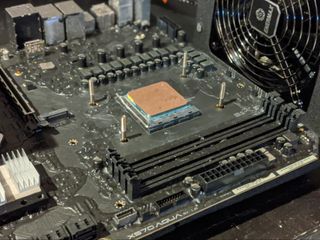
Real World Overclocking
I used the same components for real-world testing that I used for liquid nitrogen, but tapped the Enermax Aquafusion 3x120mm AIO for cooling. With my CPU already having been flattened (aka lapped), I wanted to check the surface of the AIO to make sure it was first as well.
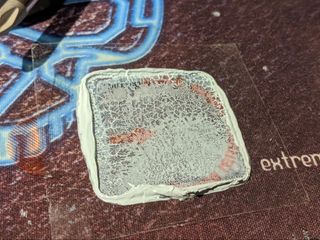
As you can see, it looks great, nice and flat!
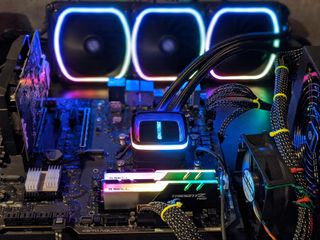
I tend to strictly favor the performance side of things, so aesthetics aren’t really in my realm of consideration. The cooler does a great job of handling the 1.4V I fed to the core at 4.55ghz through multiple loops of Cinebench R20. Temps reached the mid-80C's.
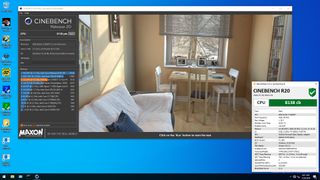
The LED wattage display on the Maxtytan PSU showed that total system power usage clipped at just above 300W during the benchmark. That’s pretty low for a maxed-out overclock on 12 powerful cores.
Stay on the Cutting Edge
Join the experts who read Tom's Hardware for the inside track on enthusiast PC tech news — and have for over 25 years. We'll send breaking news and in-depth reviews of CPUs, GPUs, AI, maker hardware and more straight to your inbox.
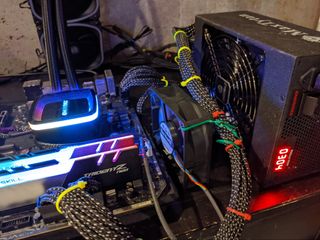
I'm a fan of fixed frequency, so I always lock my chip into the highest all-core clocks I can get, even on my daily-use computer. These chips run pretty cool for 12 cores, so fan noise, etc., is not really a problem. In this case, you can see that I hit 4.5 GHz all the time on all cores without any issues.
Pretesting for Ryzen 9 3900XT World Records
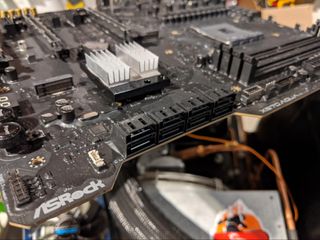
As we know, you can make some interesting performance enhancements with AMD processors by optimizing all the different multiplier ratios, including the memory, UCLK (memory controller frequency), and FCLK (fabric frequency).
Many benchmarks, especially ones that favor memory bandwidth, respond well to a 1:1:1 ratio for these three key settings. For example, you could dial in an 1800 MHz fabric, DDR4-1800 memory and 1800 MHz UCLK. If we raised our memory frequency above our fabric clock, for example, setting an 1800 MHz fabric and DDR4-2000 memory, our UCLK would drop to 1000MHz, halving the memory frequency. UCLK is the memory controller frequency, so halving it can create an efficiency problem when benching.
The fabric usually taps out between 1800-1900 MHz with normal ambient cooling, which means our optimal memory frequency is 1800-1900 MHz. On liquid nitrogen, I hit the fabric limit (before the chip fails to function) at 1600 MHz, which means a 3200 MHz total DDR4 frequency. That is pretty low in the grand scheme of things, which is tragic because AMD has a robust integrated memory controller (IMC). This gave me an idea.
Dual Rank vs Single Rank Memory on Ryzen 9 3900XT
I decided to try some old double-sided B-die memory I had sitting in a drawer. Double-sided memory is very stressful to the IMC, and thus it struggles to push high frequency compared to its single-sided brother (3933 MHz vs 4666 MHz). On the other hand, double-sided memory seems to run tight latency with no issues – it actually runs the exact same timings as single-sided.
As a result, I can swap the memory from 16GB to 32GB without even clearing CMOS and it will run fully stable. The x265 4K benchmark, which uses AVX and is very sensitive to memory on AMD platforms, gains greatly from dual-rank DMMs. In this case, I gained an extra 1 FPS, which is about a 7% performance increase in the apples-to-apples test.

This may not seem like much, but every little bit of efficiency makes life that much easier when you go to sub-ambient cooling. My chip isn’t the best out there, but with a lot of pretesting and efficiency tweaks, it gives me a chance to grab some gold medals.
On a daily use machine, I would totally recommend lower-frequency double-sided memory over fancy high-frequency single-sided memory.
LN2 Overclocking the Ryzen 9 3900XT
My memory is tuned and my operating systems are tweaked, so it's time to pour some liquid nitrogen. My rig had the following specs:
- CPU: AMD Ryzen 9 3900XT
- Motherboard: ASRock X570 Aqua
- RAM: G.SKILL TridentZ RGB 3800C14 (2x 8GB)
- RAM: G.SkILL TridentZ 3466C16 (2x 16GB)
- PSU: Enermax Maxtytan 1250W
- LN2 Pot: BBDD-DD Custom Copper LN2 Pot
- Thermal Paste: Thermal Grizzly Kryonaut LHE Edition
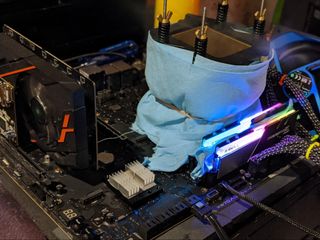
These CPUs need to be as cold as possible. My fabric limit at -192C is 1,600 MHz, and bumping up the fabric isn’t an option - even 1,633MHz creates a limit at -150C. If I go colder than that, the chip stops functioning. This isn’t optimal, but there are certainly worse chips out there. Some chips even struggle at sub-1,500 MHz.
The next step is to set a decent core voltage. I started at 1.60V. Then, I increased the CPU frequency in 50 MHz steps. After it was all said and done, the chip ran at 5,650 MHz for x265 4K, and 5710 MHz for Geekbench 3. That was enough to clinch the record for each bench.
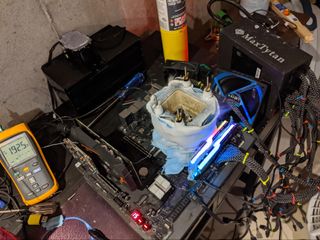
Dual rank DIMMs really gave me the edge in X265, while Geekbench seems to prefer higher frequencies for its memory tests. The ASRock X570 Aqua ran the G.Skill TridentZ RGB single-sided sticks at nearly 4700 MHz, and with very tight timings, too.
Bottom Line
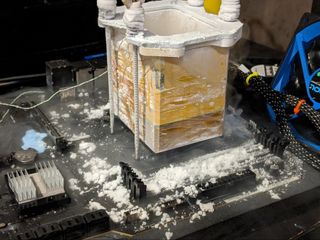
AMD’s Ryzen 9 3900XT is a frequency beast. There are plenty of LN2 results on hwbot.org that show that many 3900XT’s are running higher clocks than the best 3900X’s. It would be really cool to see a 16-core Ryzen 9 3950XT, or maybe even a Threadripper XT model (yeah right), but either way I think the top end of the Ryzen 3000 series gives us a little bit of a glimpse of what we will see with the 4000 series.
Hopefully AMD brings more frequency along with an increase in instruction-per-cycle (IPC) throughput. It would also be nice to see more memory manufacturers push high-end, dual rank B-die memory even further before we move on to DDR5.
A world-champion competitive overclocker who frequently tops the charts at HWBot, a site which tracks speed records, Allen will do just about anything to push a CPU to its limits. He shares his insights into the latest processors with Tom’s Hardware readers from a hardcore, push-it-to-the-limit overclocker’s perspective.
-
NightHawkRMX I would be interested in some R20 results under ln2.Reply
As AMD said, the architecture has matured and these chips exist because it was now possible to get even better performance out of zen2.
Honestly, the majority of people shouldn't buy XT, but they do have a purpose. -
Zarax It would also be interesting to see what the limits of ambient cooling are, has anyone managed to reach 5ghz without going to liquid?Reply -
punkncat "How I managed to do something with no real world application for cool points and to say I did."Reply -
NightHawkRMX Extreme overclocking in a nutshellReplypunkncat said:"How I managed to do something with no real world application for cool points and to say I did." -
Arbie I also don't care about OC records but was interested to hear an expert user's opinion on the quality of the 3900XT silicon. At $50 over the 3900X it's a fair offering. I don't expect price to scale absolutely linearly with performance. Those who've been criticizing AMD for releasing it have the picture wrong.Reply -
vinay2070 Reply
So are drag racing, formula 1 racing and many more. Just a sport.punkncat said:"How I managed to do something with no real world application for cool points and to say I did."
Most Popular


